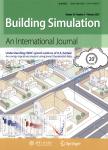版权所有:内蒙古大学图书馆 技术提供:维普资讯• 智图
内蒙古自治区呼和浩特市赛罕区大学西街235号 邮编: 010021

作者机构:School of Mechanical Engineering Tongji University Shanghai 200092 China Key Laboratory of Performance Evolution and Control for Engineering Structures of Ministry of Education Tongji University Shanghai 200092 China
出 版 物:《建筑模拟(英文版)》 (Building Simulation)
年 卷 期:2020年第13卷第6期
页 面:1291-1303页
核心收录:
学科分类:1002[医学-临床医学] 100214[医学-肿瘤学] 10[医学]
主 题:desiccant wheel solar energy heat pump nearly zero energy building humid environment
摘 要:Traditional conventional air conditioners (CACs) are not applicable to nearly zero energy buildings (NZEBs), especially for residential buildings in regions with a humid climate in China. On the one hand, indoor thermal environment can be significantly affected in buildings by adopting insulations with higher thermal resistance and air tightness. On the other hand, CACs may not be able to meet the energy requirement of NZEBs when dehumidification is in high demand. Therefore, in this paper, a novel hybrid system, which featured solar panel, a multi-evaporator and multi-condenser heat pump, and a desiccant wheel, i.e., the SHDW system was proposed. The evaporator is for pre-cooling, and the desiccant wheel (DW) for handling the whole moisture load. The regeneration air of DW is heated by heat recovery condenser and the solar panel. By varying the evaporation temperature of HP, the energy performance was evaluated, and compared with that of a typical CAC, for controlling indoor temperature and humidity of a residential NZEB, using TRNSYS. The simulations were conducted for Shanghai (in a humid climate) in summer (July and August) and the transition seasons (June and September). The results showed that, first, the optimized evaporation temperature of the system is determined to be 12 °C and 9 °C, respectively, on a typical day both in summer and the transition seasons. Second, the daily coefficient of performances are 3.4 and 2.4 in summer and in transition seasons, ***, compared to either the temperature or humidity control mode of the CAC, the proposed SHDW system showed better promise for achieving indoor thermal comfort for residential NZEBs, especially in transition seasons. In a typical weekend, the daily energy consumption of the proposed SHDW system is 9.0% and 12.3% lower than that of the CAC with humidity control mode, respectively, in summer and the transition seasons.